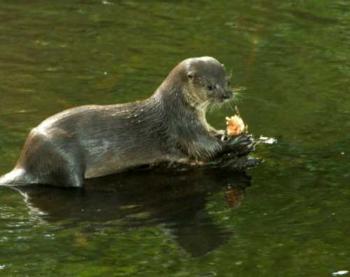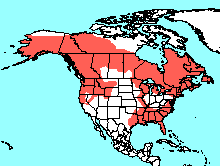 SKC Films Library SKC Films Library |
| SKC Films Library >> Science >> Zoology >> Mammals >> Order Carnivora >> Family Mustelidae |
| North American River Otter Lontra canadensis; aka Northern River Otter, River Otter, Common Otter Description Built for an aquatic lifestyle, the river otter has a long, streamlinded body, short, powerful limbs, and webbed feet. The nostrils and ears can be closed when the animal is underwater. To propel itself through the water, this species primarily combines hind-limb paddling with vertical undulations of its remarkably long, tapering tail. It is capable of staying submerged for up to 8 minutes, and can dive as deep as 60 feet. Although it is built for the water, the river otter is capable of reaching speeds of up to 18 miles an hour on land. Long whiskers help the river otter detect prey underwater. The thick, velvety fur is black, reddish or gray-brown on the back and light or gray-brown on the belly. The throat and cheeks are usually golden brown in color. The river otter can reach a length of 3-4 feet long (including the tail), a height of 10 inches at the shoulder, and a weight of 11-23 pounds. Males tend to be about 5% larger than females. Distribution and Habitat North American river otters are found throughout Canada and much of the eastern and western United States, as well as in the delta areas of the Rio Grande and Colorado rivers of Mexico. They will live just about anywhere there is a permanent food supply and easy access to water, whether it be freshwater or coastal marine habitat, warm or cold water, as long as it is pollution free.
Diet Although fish makes up the majority of its diet, the river otter will take just about any kind of aquatic animal available, as well as birds and bird eggs, small terrestrial mammals and reptiles, and even the occasional aquatic plant. A quick lunge from a position of ambush is the most commonly employed hunting method, but prolonged chases do sometimes occur. Prey is eaten immediately after capture, usually in the water, although larger prey may be eaten on land. Reproduction Mating occurs in late winter and early spring. Although it is known that males often breed with several females, it is not known whether there is any competition for mates or whether the females have a "say-so" in which males they mate with. Gestation only takes about 2 months, but since river otters practice delayed implantation births don't generally begin until March and April (10 to 12 months after mating). One to five pups are born in a den near water. They have fur but are otherwise helpless. The pups' eyes open at about one month, they are weaned and taught to swim at about 2-3 months, and will stay with the mother until about their tenth month. Males take no part in the rearing of pups. Sexual maturity is reached by the third year, and maximum lifespan in the wild is about 9 years. Other Habits and Behaviors Although they tend to live solitary lives, river otters can often be seen socializing in groups comprising dozens of individuals. When socializing, river otters use a wide variety of sounds to communicate with each other. River otters are very playful, exhibiting behaviors such as mud/snow sliding, burrowing through the snow, and waterplay. Many "play" activities actually serve a purpose. Some are used to strengthen social bonds, to practice hunting techniques, and to scent mark. North American river otters get their boundless energy from their very high metabolism, which also requires them to eat a great deal during the day. River otters maintain fairly large home ranges but are only slightly territorial, prefering avoidance over territorial conflict. Dens have underwater entrances and a tunnel leading to a nest chamber that is lined with leaves, grass, moss, bark, and hair. River otters normally hunt at night, but can be seen any time of the day. Scientific Classification phylum Chordata SOURCES |
| SKC Films Library >> Science >> Zoology >> Mammals >> Order Carnivora
>> Family
Mustelidae This page was last updated on May 16, 2017. |

